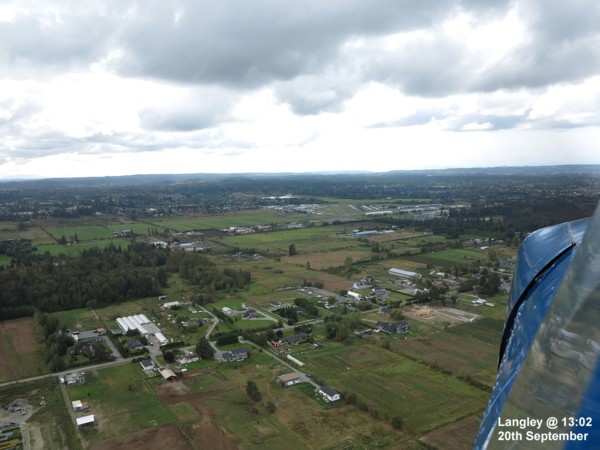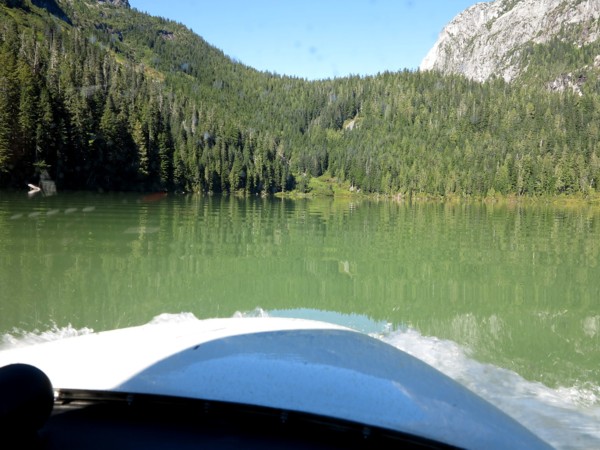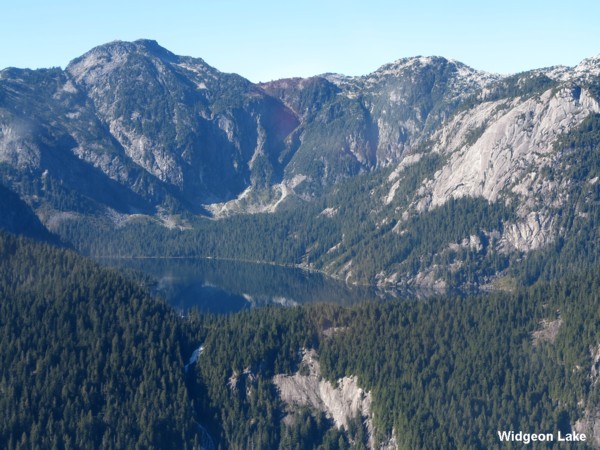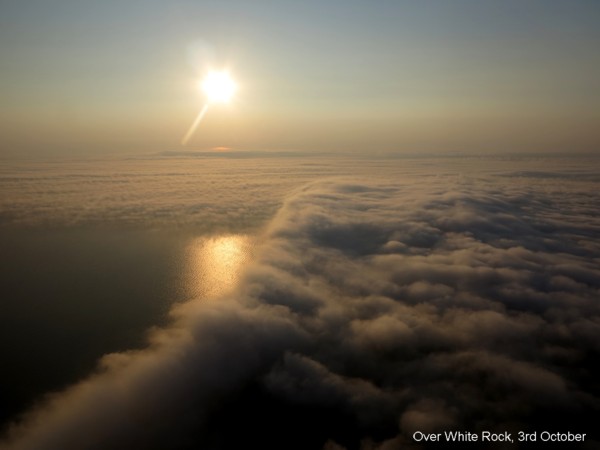

Trying to complete tasks while the fog and smoke infest the days

Smoke and mist meant curtailing flying, so
we made the best of Special VFR opportunities
Smoke from forest fires
from California, Oregon, and Washington States made VFR flying
difficult through the first two thirds of September. Fog mixed
with the smoke to create Smog and there was rain too, to make the
whole of September a difficult time with many cancellations.
With the prospect of two weeks quarantine in England, a lot of
work yet to be completed, and this being the end of the season, I
decided to rebook my flight back to Heathrow, delaying it a
further two weeks.
There's a lot for me to consider at the moment, and it's all
about timing... One needs a job for the winter and there's the
prospect of daily work in England, perhaps as Christmas Relief
for the Post Office, something I have done three times in the
past... One needs a comfortable place to live, and with similar
rental cost's and a somewhat less expensive cost of existence,
England is my best prospect.
Winter's in the Vancouver area have not been happy for me; it's
hard to make a living as an instructor, and difficult to find
even minimum wage jobs! There is little need for my talents in
Canada except being an instructor.
I have surprised some people recently as few know my history, the
jobs I have done, the talents I have demonstrated. In the
"know all" culture, I rarely tell anyone what I have
done, I never want to brag, and I know that most people want to
shine; they need it more than me. I have come across jealousy,
and envy for my apparent life as portrayed on this site, and on
Facebook.
Whether it be inspecting airliner structures, creating Computer
Based Training lessons for Pilots and Flight Attendants, and even
doing wedding photography; most people know little of what I have
done in this life. Many people are surface friendly but heart
shy, and they choose not to know a person that well.
For me, this is lonely, and a product of the busy modern World in
which we live; we don't have the time to really know each other.


As a freelance instructor it is difficult
to spread good habits to school instructors, a task that's
somewhat easier when you are the Chief Flight Instructor where it
is part of "Supervision".
Keeping the control column back to raise the elevator prevents a
lot of wear and tear to the nose leg and propeller of a Cessna
172 during the runup.
Above are a couple of pictures of the lack of care in flight training. Collapsed nose legs are a common problem, and yet this is easily prevented by simply using the elevators to keep the pressure off the nosewheel, especially during the runup.
One evening we heard the
scrape of a landing gone bad at Boundary Bay, a noise that
carried across the aerodrome. It was a Cessna 152 that hit the
runway with such force that the propeller was sheared off the
engine to scrape along for a good distance ahead of the aeroplane
which had at the same time scraped along on its broken nose leg.
The flaps were up... Many schools at Boundary Bay believe that
teaching students to land flapless to first solo is a good idea!
I think this idea is bloody stupid to put it bluntly!
The Cessna 152 was designed to be landed with the flaps down, in
this condition the pilot has a good view of the runway, the speed
is easy to control, and the landing speed relatively low. The
energy in a landing crash would be lower!
Schools that insist on teaching 70 knot
approaches with zero flaps, which can easily result in fast
porpoising landings, should look at their Safety Management!
A factor in this accident was the low Sun in the windscreen
landing on runway 25... A steeper flapped approach fills more of
the windscreen with runway and less Sun, while the shallower zero
flap approach reduces the pilot's ability to see ahead.
"Easy to difficult", students should be taught from the start to use the flaps in Cessna 150/152/172 aircraft, and when they 'get it', then a couple of landings can be done flapless as an 'emergency procedure' should the flap system fail. Landings with flaps selected and 60-65 KIAS are safe and relatively "easy" to learn.
As a side to this, I usually ask ATC at Boundary Bay for circuits on runway 31 when the Sun is low on the 25 approach. Runway 31 puts the Sun clear of the line of sight for the approach and results in an increase in safety, but the last time I asked for this it was refused.

We washed the Chipmunk to remove the
insects slaughtered during the Winnipeg trip
19th September
Flew with Brian in his
Cessna 172M for instrument flying, spins, and climbing turn
stalls.
Took Peter S for a few circuits in the Tomahawk on my account to
do some circuits myself, me in the left seat... Sometimes I pay
for my own flying for the fun of it.
20th September
Brian helped me to wash the
Chipmunk and so we went up the dry it off with loops and barrel
rolls.
Flew with Daryl in the Taifun in the afternoon... A consideration
was the left or right turn out to go to Chilliwack; right would
have meant an easy transit to the clouds forming over the
mountains, a consideration when one is flying a motor glider.

21st September
A short flight into the
Pitt Lake practice area and back from Pitt Meadows in the Taifun.
Brian flew over in his Cessna 172M for a lesson. We did steep
turns, climbing turn stalls, and then limited/partial panel
instrument flying training.
Unusual attitudes (losing control) and recoveries, then VOR
intercepts and tracking, a procedure turn, and let down back into
Pitt Meadows.

Pitt Meadows, final approach from a limited
panel VOR procedure turn and let down.
22nd September
We planned a group munch at
Chilliwack, and so I picked Alice's mum Katherine up from
Richmond in Alice's BMW Mini (which I have been driving during
this trip).
Brian flew us over to Pitt Meadows where we met Daryl. I rode
along in the right seat of the Taifun, Brian took Katherine, and
David and Gloria flew in their Piper Warrior (direct from
Boundary Bay).

Group fly out to Chilliwack

Brian had to pick me up from Pitt Meadows after our late landing there, and we took Katherine for a night flight over Vancouver where she eagerly took pictures with her phone.

Brian and I did two flights on the 24th,
and one flight on the 25th


Up in the Tomahawk with Gloria
27th September
Morning flight with Gloria
in the Tomahawk.
The circuit was full at Boundary Bay and so we went to the Glen
Valley and then to Abbotsford for a couple of circuits there.
Did a flight of just over
two hours with Brian to cover flight test exercises for the
Commercial Pilot Flight Test.
A preflight test flight is essential before recommending a
student for the actual flight test with an examiner.
28th September
Two short sets of circuits, landings, and backtracks in the Searey
Flying the Volmer Sportsman

I drove up to Squamish
early in the morning, grabbed the minimum I needed, camera,
notepad, headset, and licences, put on my lightweight 'flying'
shoes, and was picked up by Bill to drive onwards to Whistler -
Green Lake.
At Whistler I placed my wallet and mobile phone in sealed plastic
sandwich bags as a precaution against falling in!
The objective was to take the Volmer to Langley for its annual
check, and for it to be hangared for the winter.

The wind was adverse for
getting the aeroplane off Bill's floating dock where it sat on
its wheels. I stayed a landlubber to help launch the aeroplane
while springing ropes fore and aft to control the aeroplane like
a kite in the wind, but on the water!
Released, Bill taxied the Volmer to the landspit down the lake
where I took my shoes and socks off to wade into the cold glacial
water to get in.
This delayed our departure and so we called Flight Service to
amend our flight plan.
First objective was to alight on Phantom Lake, a place Bill had not yet been. This is a beautiful remote lake usually entered and departed from via its southeast end.


The next objective was to
do some power off approaches and alightings on the Pitt River...
First a normal approach, power on was made... alighting long down
the river.
I am not doing my job if I don't teach emergencies including
forced approaches with a dead engine.
In a seaplane you need extra speed for this exercise, enough to
level out above the surface and gently descend onto the water. We
can't always see the surface, it may be glassy water, and so a
higher round out is preferred (better than nosing into the water
you can't see). As the speed reduces the aeroplane hopefully
finds the surface before stalling.
So I demonstrated the first one, steep nose down, 80 mph IAS
against the natural drag of a seaplane, flared to level, and held
it there. The aeroplane touched down, skipped and stayed down.
Bill reached 81 mph on his first attempt and did a better job
than me. His second attempt was at 85 mph and this worked best of
all. 'Seems you can't have too much speed in a seaplane, it soon
loses it power off.
We do a two step flare. The initial approach angle is too steep,
and so a partial flare is made followed by the full flare to
level closer to the surface. You need trees, rocks, or a
shoreline to estimate these flare actions, but be a little on the
apparent high side with glassy water. The arrival on glassy water
is always a surprise! The hull is flown level to contact the
water on the keel, and it is not held off like a wheeled
aeroplane. The stick is moved back to maintain the level attitude
as the boat slows, sinks through the air, touches down, and then
sinks in the water to its displacement.

Bill had not been into
Widgeon Lake, one of my favourite places, and so we went in to
alight on the glassy surface.
On my side I could watch the shadow of our aeroplane grow and
slide under the floor where it met us on the surface of the lake.
The objective now was to 'S' turn to the end of the lake, turn
around and try to get onto the step using the waves we created to
break the surface. The first attempt was a no go, on the step too
late for a safe departure.
The second after zig zagging back to the end of the lake was
successful.
Glassy water is like glue if you don't get the aeroplane up on
the step, zooming along on a few inches of hull bottom, to
accelerate to takeoff speed.

Safe over the waterfall we
nosed down into the Widgeon Creek valley to fly to Langley
Airport.
Now it was time to ask permission to enter Langley's Class C
airspace without a transponder since this was on strike today!
Bill drove me back to Squamish in his 1976 Datsun 280Z and I was able to meet up for a beer with Francois, a long time instructor friend at the Watershed.
30th September
Circuits in the Searey from Delta Heritage Air Park.

We took the Chipmunk to Chilliwack for a
few circuits, and for lunch of course.
At Langley a Cessna 152
came in and did a short field landing, it was very good except
the wheels squeeled twice as the pilot applied too much brake...
I was asked how I would mark such a landing on a flight test; I
said "the approach and landing itself were a four, but the
application of brakes caused a skid, and so I'd knock off a point
for that, so it's a three". The response from both of the
others was that it would be a 1 out of 4 which is a fail!
I reckon that it is actually difficult when one consults the POH
where it mentions something like: 'application of maximum
braking'. I think a student can be forgiven for using too much
brake. The tyres squeeled twice, but not to the extent that
significant flats in the treads would have been created. Was
safety compromised? No. Was the exercise achieved? Yes. Was it a
polished performance? No. Was it a fail? In my opinion: No, at
worse a 2/4, and something to discuss with the candidate after
the flight.
Such is the disparity between opinions, subjectiveness, and how a
flight test can be failed so easily.

Smoke and mist over Vancouver
In the evening I flew with Brad in Brian's Cessna 172M to do a couple of Practice Forced Landings followed by circuits into the night at Boundary Bay.


Circuits in the Searey
2nd October
Began with circuits in the
Searey out of Delta Heritage Air Park.
In the afternoon I flew with Daryl in the Taifun first and then
did a flight with Niklas in it.
The idea is to form a 'soaring group' at Pitt Meadows with the
Valentin Taifun 17E, this will provide a chance for people to
learn gliding principles at an airport near to both Vancouver and
the mountains.
Niklas has flown gliders and motor gliders in Germany and is an
enthusiast, he is young, and is passionate about flying.

Langley
3rd October
Flying was impossible from
Boundary Bay due to low lying fog... This has been an ongoing
problem recently.
It was clear enough when I arrived at Langley and so I took the
Chipmunk on a quick survey flight with a touch and go at Pitt
Meadows.
Back at Langley my landing was rated as "a work of art"
it was so smooth and gentle.


Cancel the flight test, Boundary Bay is
under the fog.

Like a Cancer; developments of wooden sheds and boxes (aka
chipboard and 2"x4" apartments) provide for a growing
population and greater congestion on the Lower Mainland's roads.
5th October
I did another preflight test with Brian in the Cessna 172M
6th October...
...Was a day at Pitt
Meadows for me... Fog prevented flying from Boundary Bay in the
morning.
In the afternoon Brian brought Brad over to Pitt Meadows in the
Cessna 172M for some more Private Pilot exercises to meet the
recurrency requirements for his licence.
Then I did a flight with Roel who has also been too busy to get
much flying in recently.
I flew twice in the Taifun, first with Daryl and then with Niklas.

Up to Pitt Lake with Niklas to check him out in the right seat.

Yesterday my Commercial Pilot Licence student, Brian, successfully passed his Flight Test. Congratulations Brian.
